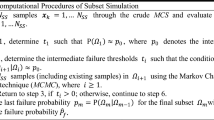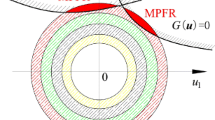Abstract
Importance sampling methods are widely used in structural reliability analysis. However, owing to the complex shape of optimal importance sampling densities, it is usually difficult to fit the optimal importance sampling densities and sample from the fitted distributions using conventional importance sampling methods. In this paper, a novel importance sampling method based on interpretable deep generative network (IDGN-IS) is proposed for structural reliability analysis. The proposed IDGN-IS model can be directly trained using the data from original distribution of random variables and efficiently sampling from an arbitrary importance sampling density. The developed interpretable deep generative network consists of a deep generative network and a monotonic network, which enables the network to fit and sample from the target distributions while being interpretable. Using the interpretability of the deep generative network, the IDGN-IS method can sample from an arbitrary conditional probability distribution of the fitted distributions by choosing an appropriate threshold of the input Gaussian distribution samples. When the threshold of the input Gaussian distribution samples is set to a value close to zero, the IDGN-IS method can efficiently sample from the optimal importance sampling density and provide accurate estimation of the failure probability. The calculation efficiency and estimation accuracy of the proposed IDGN-IS method in structural reliability analysis are demonstrated using four examples.


















Similar content being viewed by others
Data availability
No additional data are available.
References
Ang AS, Tang W (1975) Probability concepts in engineering planning and design[M]. Wiley
Melchers RE (1999) Structural reliability analysis and prediction, 2nd edn. Wiley, West Sussex
Zhao YG, Ono T (1999) A general procedure for first/second-order reliability method (FORM/SORM)[J]. Struct Saf 21(2):95–112
Moustapha M, Marelli S, Sudret B (2022) Active learning for structural reliability: Survey, general framework and benchmark[J]. Struct Saf. https://doi.org/10.1016/j.strusafe.2021.102174
Guimarães H, Matos JC, Henriques AA (2018) An innovative adaptive sparse response surface method for structural reliability analysis[J]. Struct Saf 73:12–28
Zhou Y, Lu Z, Yun W (2020) Active sparse polynomial chaos expansion for system reliability analysis[J]. Reliab Eng Syst Saf. https://doi.org/10.1016/j.ress.2020.107025
Cheng K, Lu Z (2021) Adaptive Bayesian support vector regression model for structural reliability analysis[J]. Reliab Eng Syst Saf 206:107286
Yang J, Cheng L, Ran L (2021) Research on slope reliability analysis using multi-kernel relevance vector machine and advanced first-order second-moment method[J]. Eng Comput. https://doi.org/10.1007/s00366-021-01331-9
Zhang D, Zhou P, Jiang C et al (2021) A stochastic process discretization method combing active learning Kriging model for efficient time-variant reliability analysis[J]. Comput Methods Appl Mech Eng 384:113990
Zhou T, Peng Y (2021) Active learning and active subspace enhancement for PDEM-based high-dimensional reliability analysis[J]. Struct Saf 88:102026
Zhang X, Pandey MD, Yu R et al (2021) HALK: A hybrid active-learning Kriging approach and its applications for structural reliability analysis[J]. Eng Comput. https://doi.org/10.1007/s00366-021-01308-8
Zhou C, Xiao NC, Zuo MJ et al (2021) An improved Kriging-based approach for system reliability analysis with multiple failure modes[J]. Eng Comput. https://doi.org/10.1007/s00366-021-01349-z
Bao Y, Xiang Z, Li H (2021) Adaptive subset searching-based deep neural network method for structural reliability analysis[J]. Reliab Eng Syst Saf 213:107778
Xiang Z, Bao Y, Tang Z et al (2020) Deep reinforcement learning-based sampling method for structural reliability assessment[J]. Reliab Eng Syst Saf. https://doi.org/10.1016/j.ress.2020.106901
Ren C, Aoues Y, Lemosse D et al (2022) Ensemble of surrogates combining kriging and artificial neural networks for reliability analysis with local goodness measurement[J]. Struct Saf 96:102186
Rubinstein RY, Kroese DP (2016) Simulation and the monte carlo method[M]. Wiley
Yuan X, Liu S, Faes M et al (2021) An efficient importance sampling approach for reliability analysis of time-variant structures subject to time-dependent stochastic load[J]. Mech Syst Signal Process 159:107699
Guo H, Dong Y, Gardoni P (2022) Efficient subset simulation for rare-event integrating point-evolution kernel density and adaptive polynomial chaos kriging[J]. Mech Syst Signal Process 169:108762
Abdollahi A, Azhdary Moghaddam M, Hashemi Monfared SA et al (2021) Subset simulation method including fitness-based seed selection for reliability analysis[J]. Eng Comput 37(4):2689–2705
Zhang X, Lu Z, Cheng K (2021) AK-DS: An adaptive Kriging-based directional sampling method for reliability analysis[J]. Mech Syst Signal Process 156:107610
Papaioannou I, Straub D (2021) Combination line sampling for structural reliability analysis[J]. Struct Saf 88:102025
Au SK, Beck JL (1999) A new adaptive importance sampling scheme for reliability calculations[J]. Struct Saf 21(2):135–158
Wang Z, Song J (2016) Cross-entropy-based adaptive importance sampling using von Mises-Fisher mixture for high dimensional reliability analysis[J]. Struct Saf 59:42–52
Papaioannou I, Geyer S, Straub D (2019) Improved cross entropy-based importance sampling with a flexible mixture model[J]. Reliab Eng Syst Saf 191:106564
Kanjilal O, Papaioannou I, Straub D (2022) Series system reliability of uncertain linear structures under gaussian excitation by cross entropy-based importance sampling[J]. J Eng Mech 148(1):04021136
Zhao Z, Lu ZH, Zhao YG (2022) Time-variant reliability analysis using moment-based equivalent Gaussian process and importance sampling[J]. Struct Multidiscip Optim 65(2):1–17
Zhang X, Wang L, Sørensen JD (2020) AKOIS: an adaptive Kriging oriented importance sampling method for structural system reliability analysis[J]. Struct Saf 82:101876
Yun W, Lu Z, Wang L et al (2021) Error-based stopping criterion for the combined adaptive Kriging and importance sampling method for reliability analysis[J]. Probab Eng Mech 65:103131
Zhang J, Xiao M, Gao L et al (2019) A combined projection-outline-based active learning Kriging and adaptive importance sampling method for hybrid reliability analysis with small failure probabilities[J]. Comput Methods Appl Mech Eng 344:13–33
Xiao NC, Zhan H, Yuan K (2020) A new reliability method for small failure probability problems by combining the adaptive importance sampling and surrogate models[J]. Comput Methods Appl Mech Eng 372:113336
Liu H, He X, Wang P et al (2022) Time-dependent reliability analysis method based on ARBIS and Kriging surrogate model[J]. Eng Comput. https://doi.org/10.1007/s00366-021-01570-w
Tabandeh A, Jia G, Gardoni P (2022) A review and assessment of importance sampling methods for reliability analysis[J]. Struct Saf 97:102216
Wan X, Wei S (2020) Coupling the reduced-order model and the generative model for an importance sampling estimator[J]. J Comput Phys 408:109281
Dinh L, Sohl-Dickstein J, Bengio S (2016) Density estimation using real nvp[J]. arXiv preprint arXiv:1605.08803
Sill J (1997) Monotonic networks[J]. Advances in neural information processing systems 10. https://proceedings.neurips.cc/paper/1997/hash/83adc9225e4deb67d7ce42d58fe5157c-Abstract.html
Geyer S, Papaioannou I, Straub D (2019) Cross entropy-based importance sampling using Gaussian densities revisited[J]. Struct Saf 76:15–27
Papaioannou I, Papadimitriou C, Straub D (2016) Sequential importance sampling for structural reliability analysis[J]. Struct Saf 62:66–75
Au SK, Beck JL (2001) Estimation of small failure probabilities in high dimensions by subset simulation[J]. Probab Eng Mech 16(4):263–277
Xiang Z, Chen J, Bao Y et al (2020) An active learning method combining DNN and weighted sampling for structural reliability analysis[J]. Mech Syst Signal Process 140:106684
China, Ministry of Communications (2020) JTG/T 3365-01-2020, Specifications for Design of Highway Cable-stayed Bridge. Beijing: China Communications Press
Su G, Peng L, Hu L (2017) A Gaussian process-based dynamic surrogate model for complex engineering structural reliability analysis[J]. Struct Saf 68:97–109
Funding
This work was supported by the National Natural Science Foundation of China (Nos. 51925808, U1934209, and 52208223), the Science and Technology Research and Development Program Project of China railway group limited (Major Special Project, No. 2021-Special-04-2), the Tencent Foundation (Xplorer Prize 2021), and China Postdoctoral Science Foundation (No. 2022M713545).
Author information
Authors and Affiliations
Contributions
ZX: Conceptualization, Methodology, Software, Investigation, Writing—Original Draft; XH: Resources, Writing—Review and Editing, Project administration, Funding acquisition, Supervision; Yunfeng Zou: Writing—Review and Editing, Supervision; HJ: Writing—Review and Editing, Supervision.
Corresponding author
Ethics declarations
Conflict of interest
The authors declare that they have no conflict of interest.
Additional information
Publisher's Note
Springer Nature remains neutral with regard to jurisdictional claims in published maps and institutional affiliations.
Rights and permissions
Springer Nature or its licensor (e.g. a society or other partner) holds exclusive rights to this article under a publishing agreement with the author(s) or other rightsholder(s); author self-archiving of the accepted manuscript version of this article is solely governed by the terms of such publishing agreement and applicable law.
About this article
Cite this article
Xiang, Z., He, X., Zou, Y. et al. An importance sampling method for structural reliability analysis based on interpretable deep generative network. Engineering with Computers 40, 367–380 (2024). https://doi.org/10.1007/s00366-023-01790-2
Received:
Accepted:
Published:
Issue Date:
DOI: https://doi.org/10.1007/s00366-023-01790-2




